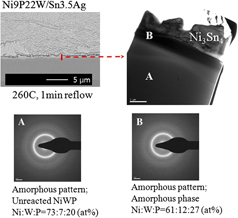Article contents
Tungsten alloying of the Ni(P) films and the reliability of Sn–3.5Ag/NiWP solder joints
Published online by Cambridge University Press: 21 March 2011
Abstract

Effects of tungsten (W) addition to the electroless Ni(P) under bump metallization (UBM) on the solder joint reliability were investigated by preparing Ni–xW–5P and Ni–xW–9P films. Characteristics of the NiWP films, interfacial reaction with Sn–3.5Ag solder, and the impact resistance of solder joints was investigated by conducting differential scanning calorimetry, x-ray diffraction, scanning electron microscopy, transmission electron microscopy (TEM), and drop tests. Tungsten increased the thermal stability of the film and raised the crystallization temperature, but the crystallinity decreased with the W content in the film. The drop impact resistance of the Sn–3.5Ag/Ni–xW–9P joints was improved remarkably with the W content in the UBM, which was a direct consequence of the elimination of Ni3Sn4 spalling from the UBM. Additions of W up to 16 wt.% did not suppress intermetallic compound (IMC) spalling completely, but 22 wt.% W did up to 4 reflows, which increased the number of drops to failure (Nf) from 50 to over 300. TEM study showed the presence of an amorphous (Ni,W)3P layer between Ni3Sn4 and the original Ni–22W–9P UBM.
Keywords
- Type
- Articles
- Information
- Copyright
- Copyright © Materials Research Society 2011
References
REFERENCES
- 12
- Cited by


